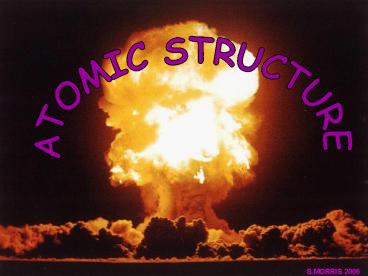Atomic structure - PowerPoint PPT Presentation
Title:
Atomic structure
Description:
Title: Atomic structure Author: S.MORRIS Last modified by: Kelly Brown Created Date: 7/9/2006 10:27:47 AM Document presentation format: On-screen Show (4:3) – PowerPoint PPT presentation
Number of Views:89
Avg rating:3.0/5.0
Title: Atomic structure
1
ATOMIC STRUCTURE
S.MORRIS 2006
2
HISTORY OF THE ATOM
Democritus develops the idea of atoms
460 BC
he pounded up materials in his pestle and mortar
until he had reduced them to smaller and smaller
particles which he called
ATOMA (greek for indivisible)
3
HISTORY OF THE ATOM
John Dalton
1808
suggested that all matter was made up of tiny
spheres that were able to bounce around with
perfect elasticity and called them
ATOMS
4
HISTORY OF THE ATOM
Joseph John Thompson
1898
found that atoms could sometimes eject a far
smaller negative particle which he called an
ELECTRON
5
HISTORY OF THE ATOM
1904
Thompson develops the idea that an atom was made
up of electrons scattered unevenly within an
elastic sphere surrounded by a soup of positive
charge to balance the electron's charge
like plums surrounded by pudding.
PLUM PUDDING MODEL
6
HISTORY OF THE ATOM
Ernest Rutherford
1910
oversaw Geiger and Marsden carrying out his
famous experiment. they fired Helium nuclei at
a piece of gold foil which was only a few atoms
thick. they found that although most of them
passed through. About 1 in 10,000 hit
7
HISTORY OF THE ATOM
gold foil
helium nuclei
helium nuclei
They found that while most of the helium nuclei
passed through the foil, a small number were
deflected and, to their surprise, some helium
nuclei bounced straight back.
8
HISTORY OF THE ATOM
Rutherfords new evidence allowed him to propose
a more detailed model with a central nucleus.
He suggested that the positive charge was all
in a central nucleus. With this holding the
electrons in place by electrical
attraction However, this was not the end of the
story.
9
HISTORY OF THE ATOM
Niels Bohr
1913
studied under Rutherford at the Victoria
University in Manchester.
Bohr refined Rutherford's idea by adding that the
electrons were in orbits. Rather like planets
orbiting the sun. With each orbit only able to
contain a set number of electrons.
10
Bohrs Atom
electrons in orbits
nucleus
11
HELIUM ATOM
Shell
proton
N
-
N
-
neutron
electron
What do these particles consist of?
12
ATOMIC STRUCTURE
Particle
Charge
Mass
proton
ve charge
1
neutron
No charge
1
electron
-ve charge
nil
13
ATOMIC STRUCTURE
He
2
Atomic number
the number of protons in an atom
4
Atomic mass
the number of protons and neutrons in an atom
number of electrons number of protons
14
ATOMIC STRUCTURE
Electrons are arranged in Energy Levels or Shells
around the nucleus of an atom.
- first shell a maximum of 2 electrons
- second shell a maximum of 8 electrons
- third shell a maximum of 8 electrons
15
ATOMIC STRUCTURE
There are two ways to represent the atomic
structure of an element or compound
1. Electronic Configuration
2. Dot Cross Diagrams
16
ELECTRONIC CONFIGURATION
With electronic configuration elements are
represented numerically by the number of
electrons in their shells and number of shells.
For example
Nitrogen
configuration 2 , 5
7
2 in 1st shell 5 in 2nd shell
N
2 5 7
14
17
ELECTRONIC CONFIGURATION
Write the electronic configuration for the
following elements
20
11
8
O
Na
Ca
a)
b)
c)
16
23
40
2,8,8,2
2,8,1
2,6
17
14
5
Cl
Si
B
d)
e)
f)
11
35
28
2,8,7
2,8,4
2,3
18
DOT CROSS DIAGRAMS
With Dot Cross diagrams elements and compounds
are represented by Dots or Crosses to show
electrons, and circles to show the shells. For
example
X
Nitrogen
N
7
N
X
X
X
X
14
X
X
19
DOT CROSS DIAGRAMS
Draw the Dot Cross diagrams for the following
elements
X
8
17
X
O
Cl
a)
b)
X
35
X
16
X
X
X
X
X
Cl
X
X
X
X
X
X
O
X
X
X
X
X
X
X
X
X
X
X
20
SUMMARY
- The Atomic Number of an atom number of
- protons in the nucleus.
- The Atomic Mass of an atom number of
- Protons Neutrons in the nucleus.
- The number of Protons Number of Electrons.
- Electrons orbit the nucleus in shells.
- Each shell can only carry a set number of
electrons.































